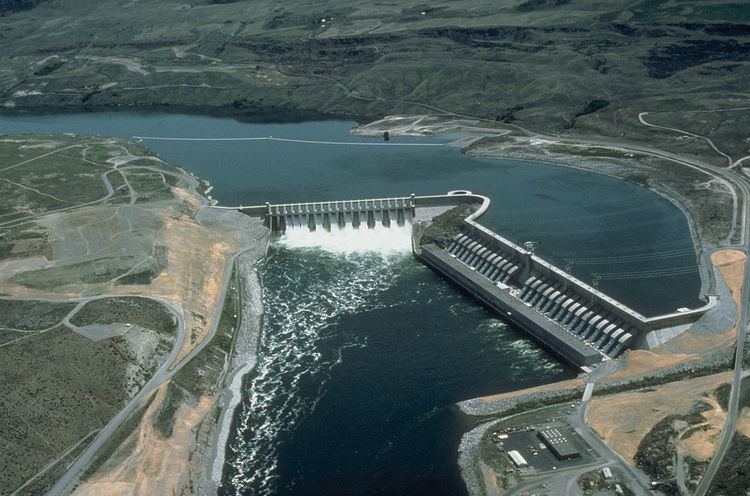 | ||
Run-of-the-river hydroelectricity (ROR) or run-of-river hydroelectricity is a type of hydroelectric generation plant whereby little or no water storage is provided. Run-of-the-river power plants may have no water storage at all or a limited amount of storage, in which case the storage reservoir is referred to as pondage. A plant without pondage has no water storage and is, therefore, subject to seasonal river flows. Thus, the plant will operate as an intermittent energy source while a plant with pondage can regulate the water flow at all times and can serve as a peaking power plant or base load power plant.
Contents
Concept
Run-of-the-river or ROR hydroelectricity is considered ideal for streams or rivers that can sustain a minimum flow or those regulated by a lake or reservoir upstream. A small dam is usually built to create a headpond ensuring that there is enough water entering the penstock pipes that lead to the turbines which are at a lower elevation. Projects with pondage, as opposed to those without pondage, can store water for daily load demands. In general, projects divert some or most of a river's flow (up to 95% of mean annual discharge) through a pipe and/or tunnel leading to electricity-generating turbines, then return the water back to the river downstream.
ROR projects are dramatically different in design and appearance from conventional hydroelectric projects. Traditional hydro dams store enormous quantities of water in reservoirs, sometimes flooding large tracts of land. In contrast, run-of-river projects do not have most of the disadvantages associated with dams and reservoirs, which is why they are often considered environmentally friendly.
The use of the term "run-of-the-river" for power projects varies around the world. Some may consider a project ROR if power is produced with no water storage while limited storage is considered ROR by others. Developers may mislabel a project ROR to soothe public perception about its environmental or social effects. The Bureau of Indian Standards describes run-of-the-river hydroelectricity as:
A power station utilizing the run of the river flows for generation of power with sufficient pondage for supplying water for meeting diurnal or weekly fluctuations of demand. In such stations, the normal course of the river is not materially altered.
Many of the larger ROR projects have been designed to a scale and generating capacity rivaling some traditional hydro dams. For example, the Beauharnois Hydroelectric Generating Station in Quebec is rated at 1,853 MW and a 2006 proposal in British Columbia, Canada has been designed to generate 1027 megawatts capacity. Some run of the river projects are downstream of other dams and reservoirs. The run of the river project didn't build the reservoir, but does take advantage of the water supplied by it. An example would be the 1995, 1,436 MW La Grande-1 generating station, previous upstream dams and reservoirs are part of the 1980s James Bay Project.
Advantages
When developed with care to footprint size and location, ROR hydro projects can create sustainable energy minimizing impacts to the surrounding environment and nearby communities. Advantages include:
Cleaner power, fewer greenhouse gases
Like all hydro-electric power, run-of-the-river hydro harnesses the natural potential energy of water, eliminating the need to burn coal or natural gas to generate the electricity needed by consumers and industry. Moreover, run-of-the-river hydro-electric plants do not require the formation of a reservoir (unlike conventional hydro-electric plants) thus eliminating the methane and carbon dioxide emissions generally caused by the decomposition of organic matter in the reservoir of a hydro-electric dam.
Less flooding/reservoirs
Substantial flooding of the upper part of the river is not required for run-of-river projects as a large reservoir is not required. As a result, people living at or near the river don't need to be relocated and natural habitats and productive farmlands are not wiped out.
"Unfirm" power
Run-of-the-River power is considered an "unfirm" source of power: a run-of-the-river project has little or no capacity for energy storage and hence can't co-ordinate the output of electricity generation to match consumer demand. It thus generates much more power during times when seasonal river flows are high (i.e., spring freshet), and depending on location, much less during drier summer months or frozen winter months.
Availability of sites
The potential power at a site is a result of the head and flow of water. By damming a river, the head is available to generate power at the face of the dam. Where a dam may create a reservoir hundreds of kilometers long, in run of the river the head is usually delivered by a canal, pipe or tunnel constructed upstream of the power house. Due to the cost of upstream construction, a steep drop in the river is desirable.
Environmental impacts
Small, well-sited ROR projects can be developed with minimal environmental impacts. Larger projects have more environmental concerns. For example, Plutonic Power Corp.'s canceled Bute Inlet Hydroelectric Project in BC would have seen three clusters of run-of-river projects with 17 river diversions; as proposed, this run-of-river project would divert over 90 kilometres of streams and rivers into tunnels and pipelines, requiring 443 km of new transmission line, 267 km of permanent roads, and 142 bridges to be built in wilderness areas.
British Columbia's mountainous terrain and wealth of big rivers have made it a global testing ground for run-of-river technology. As of March 2010, there were 628 applications pending for new water licences solely for the purposes of power generation – representing more than 750 potential points of river diversion.
